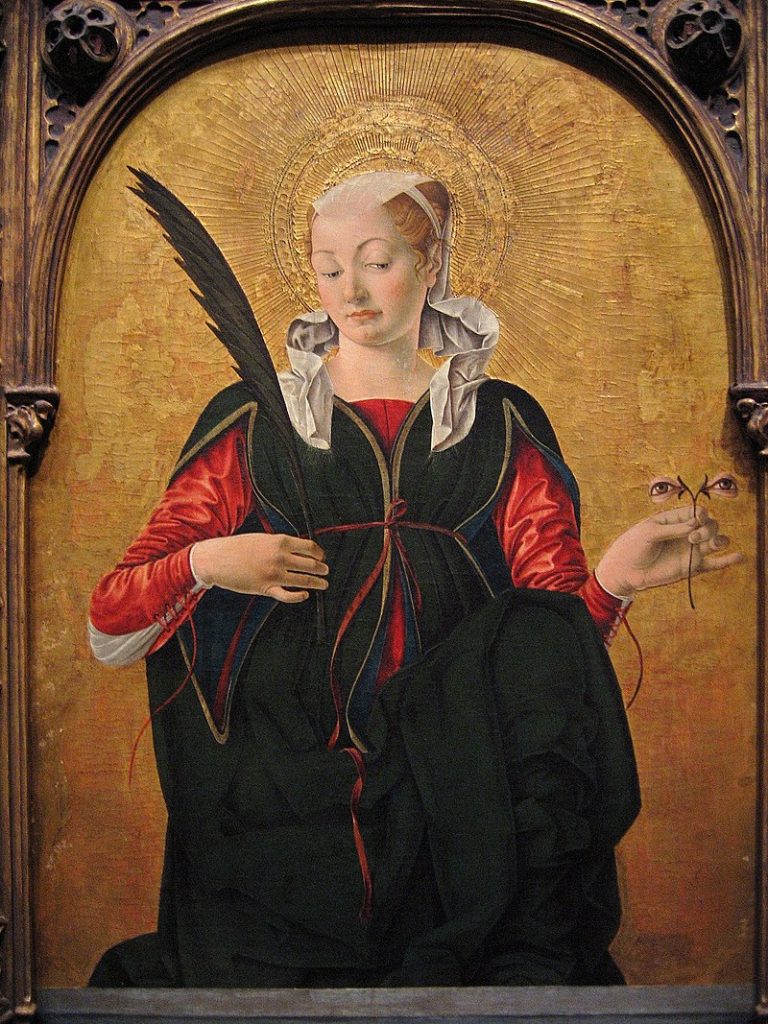
The name Lucy is from the same Latin origin (Lucidus) as lucent, lux, and lucid. It means to be bright, to shine or be clear. It is similar to the Ancient Greek λευκός (leukós, “white, blank, light, bright, clear”. Luke has the same origins (bright one, bringer of light and light of the sacred flame) and is very appropriate for the most literate of the evangelists.
I am just noticing how dim the daylight is even before noon. So, at this time of the year, we are in need of a festival with bright lights to cheer us up! And St Lucy’s Day is the beginning of the winter festival that culminates with the Solstice, where the old sun dies, and the new one is born. December the 13th was the Solstice until Pope Gregory reformed the Calendar in the 16th Century, as nine days were lopped off the year of transition.
The festival of Sankta Lucia is particularly popular in Sweden, where Dec 13th is thought to be the darkest night. In recent years, the Swedish community in the UK has had a service to Lucia in St Pauls. But this year it is in Westminster Cathedral. But as usual, it is sold out by the time I get around to thinking of going!

I found out about Sankta Lucia from a Swedish choir who hired me to do a tour of the City of London some years ago. I took them into Christopher Wren’s marvellous St Stephen’s Church and, under the magnificent Dome, they fancied the acoustics and spontaneously sang. I recorded a snatch of it, which you can hear below

Watch the procession in St Pauls on youtube below.
Recent medical research has shown the importance of light, not only to our mental health but to our sleep health, and recommends that work places have a decent light level with ‘blue light’ as a component of the lighting. It is also an excellent idea to help your circadian rhymes by going for a morning walk, or morning sun bathing, even on cloudy days.
St Lucy is from Syracuse in Sicily, said to be a victim of the Diocletian Persecution of Christians in the early 4th Century. She is an authentic early martyr, although details of her story cannot be relied upon as true. She was said to be a virgin, who was denounced as a Christian by her rejected suitor, miraculously saved from serving in a brothel, then, destruction by fire, but did not escape having her eyes gouged out. Finally, her throat was cut with a sword. Her connection to light (and the eye gouging) makes her the protectress against eye disease, and she is often shown holding two eyes as you can see above. Other symbols include a palm branch which represents martyrdom and victory over evil She can also be seen with lamp, dagger, sword or two oxen. She appears in Dante’s Divine Comedy, as the messenger to Beatrice whose job is to get Virgil to help Dante explore Heaven, Hell and Heaven. Beatrice takes over as the guide around Paradise because Virgil is a pagan and so cannot enter it.
St. Aldhelm (died in 709) puts St Lucy in the list of the main venerated saints of the early English Church, confirmed by the Venerable Bede (died in 735). Her festival was an important one in England ‘as a holy day of the second rank in which no work but tillage or the like was allowed’.
First Posted on December 13th, 2022, updated on December 13th 2023 and 2024
